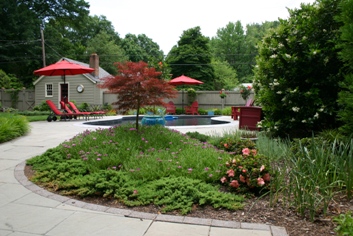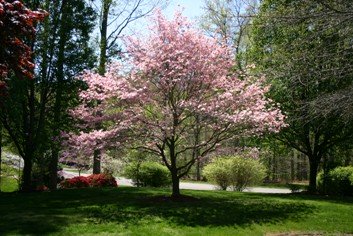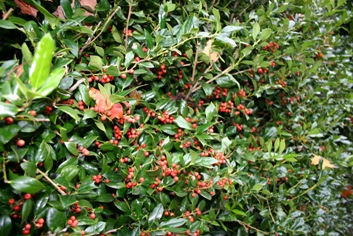|
Don't Let Pruning Intimidate You!Pruning is something done on a regular basis to keep your plants healthy. You do need to know some basic information about the plant in order to best do this task. Do some research and planning before you start for optimum results. Using the correct techiques and tools for this job makes a huge difference in your landscape's appearance. The preparatory time spent in the beginning will give you life-long results that make your landscaping grow more valuable each year.
This beautiful pink dogwood is shaped perfectly! It was trimmed at the proper time because it it full of flowers, the buds were not removed by cutting it at the wrong time. The canopy has been thinned because there is not a lot of criss crossing branches. The natural horizontal branching and rounded crown have been maintained. This specimen provides an incredible display of spring flowers and is a beautiful tree all year, as well!
Your landscape plan provides the name of the plant that you wish to prune which is your starting point.
Secondly, learn the natural shape of the plant. For example, does it naturally grow as a pyramid or a rounded plant? Ask this question of your landscape design professional or your local garden center. The natural shape is the shape you want to maintain. Poorly and incorrectly shaped plants can create plants that mature into odd looking specimens. Also, trying to make the plant grow in an unnatural shape is going to take shaping it more often which creates more maintenance for you.
This Dwarf Burford Holly is covered with red berries in the winter. Trim in late winter, so you do not remove the inconspicuous spring flowers that mature into summer green berries that turn red in the winter. The late winter is the best time to trim winter berrying plants.
There are only two times a year in Central Virginia that you do major pruning. In the late winter for berry producing plants and evergreens without showy flowers. This is also the appropriate time to cut back summer flowering plants. Trim spring flowering plants immediately after the flowering plant blooms. You will be pruning throughout the spring, if you have plants that bloom during all the spring months. For example, an azalea that blooms in April is shaped before a rhododentron that blooms in May. If you shape these plants prior to blooming, you will be removing the flower buds. It is important to understand that flower bud production on spring flowering plants is during the spring and summer of the year prior to when it blooms. Therefore, if you do not trim these plants soon after they bloom, you will be removing next year’s flower buds. Organizing when to prune the landscape plants on your property can be easily done by breaking them down into these simple categories. Removing new growth that looks unruly can be done anytime.

When plants are pruned correctly they add a variety of color, shape, form and texture. Too often I see a property owner cut back all their plants to one size and shape. What a mistake! The various attributes of a plant is what adds to a landscape's beauty. In this photo, the Japanese maple has a soft natural shape and is going to grow into a beautiful 15 foot tree. It is a slow grower, so does not need to be trimmed often. The ice plant growing around its trunk is an evergreen groundcover that blooms in the summer. Keep it trimmed within its boundaries during the growing season, but do not cut off top growth that provides flowers. The juniper in front of it hugs the ground. The growing tips are trimmed to keep it from growing too far over the pool deck. A nice layered look is created and maintained because of proper pruning.
Does pruning still intimidate you? Please ask me questions about pruning or any other landscape topic. I would enjoy hearing from you. Your question will be answered within a few days. You get your own web page to share with friends and our readers. Please
contact me
to inquire about my landscape design services:
|









